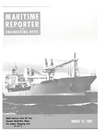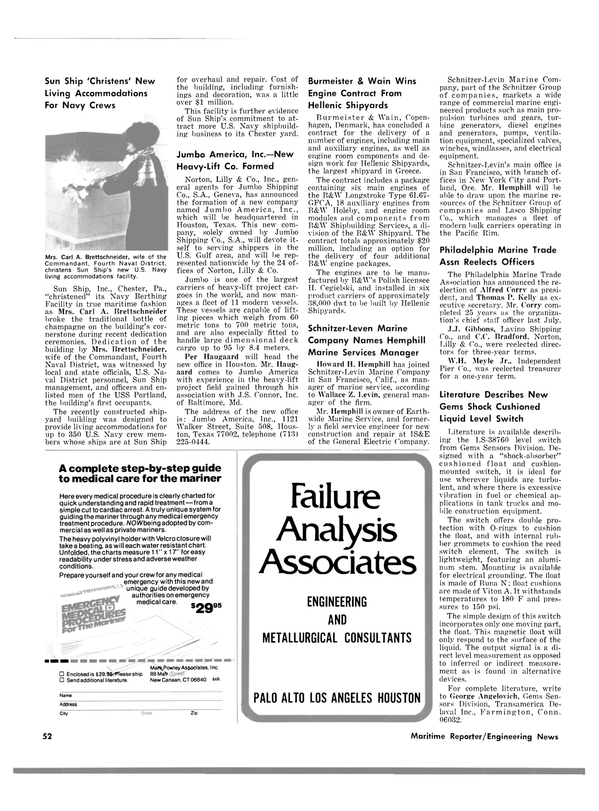
R.J. Brown & Associates Receive Esso Contract For Pipeline Post-Trenching Plow
R.J. Brown and Associates has been awarded a contract by Esso Australia Ltd. for the design of an underwater plow to trench-in a pipeline following its installation in Bass Strait, off Southeast Australia. The 23-mile 24-inch gas transmission line will connect the Snapper "A" production platform to shore at Ninety Mile Beach. RJBA's responsibilities cover design, supervision of fabrication and testing, development of procedures, and supervision of plowing operations including deployment, towing and recovery of the plow. Fabrication of the plow structure and installation of associated instrumentation is being performed by Harbour & Marine Engineering Pty. Ltd. of Melbourne, under RJBA supervision, with completion of manufacture scheduled for March 1980.
RJBA will supervise the testing of the plow onshore and offshore Barry Beach, Bass Strait. Trenching of the Snapper pipeline will start at the inshore end, with the plow being towed by a barge or tug through the outer surf zone and progressively seaward to the production platform which stands in a water depth of approximately 200 feet. The soil along the route is carbonate sand, with locally- cemented areas, through which the plow will cut a Vee-shaped trench of about 4-foot depth. It is anticipated that trenchingin the full length of the pipeline will only occupy several days.
Overall, use of a plow is intended to reduce the risk of damage occurring during pipeline trenching operations, to reduce the time required to stabilize the line on the seabed, and to reduce the cost of pipe burial.
The RJBA post-trenching plow which, it is believed, will be the first of its type to be built, tested and commercially utilized, is the outcome of a long-term development and model-testing program which was initiated on behalf of Esso Australia in 1977, with a technical economic feasibility study. Subsequently in 1978, a 29-foot long, 1:3 scale pre-trenching plow of RJBA design was built and successfully tested in Australia onshore and offshore the Gippsland Shelf Area, Bass Strait. This plow was used to pre-cut a 36-inch-deep trench through the 2 3-mile surf zone during the shore-pull of the Snapper pipeline at the start of pipelay operations in November last year.
The new post-trenching plow measures 60 feet long, 26 feet wide and 12 feet high, and will weigh around 65 tons. It comprises a main structural beam which is supported at the front on two wide-flanged wheels, and at the back on skids either side of the pipeline.
Innovative features of the plow's design include (1) the use of a hinged, split share which facilitates deployment of the plow around the pipeline and its subsequent retrieval, (2) attachment of the tow cable to the halves of the split share so that the towing force is applied to the component which is subject to the maximum plowing load; this arrangement assists in reducing the overall weight, (3) the use of rollers fore and aft to protect the pipeline when passing through the plow and which, at the front, are used to guide the wheels along the pipeline route, (4) means for depth-of-cut adjustment during towing by variation in the vertical positioning of the rear support skids, and (5) use of remote-reading instrumentation on the plow to provide the tow vessel with signals of tow cable tension, tow cable angle relative to the plow, and plow cutting depth.
In late 1978 early 1979, prior to design and construction of the full-scale post-trenching plow, RJBA, on behalf of Esso Australia, built and tested 1:50 and 1:5 scale model plows. The 1:50 scale model was used to confirm the closure mechanism of the split share and to develop operating and retrieval procedures for the plow. The 1:5 scale plow, which was tested on the beach at Den Helder in northwest Holland, was used to determine the pull forces required for differing depths of the trench, to confirm the correct operation of the plow, and to determine structural loads and stresses on the plow.
R.J. Brown and Associates is an international company headquartered in Switzerland, and with engineering offices in the Netherlands; Houston, Texas; and Singapore.
Work on the Esso Australia plows has been handled by engineers from the Netherlands and Singapore offices. R.J. Brown and Associates provides a wide range of engineering and project management services to the offshore pipeline industry worldwide.
Read R.J. Brown & Associates Receive Esso Contract For Pipeline Post-Trenching Plow in Pdf, Flash or Html5 edition of March 15, 1980 Maritime Reporter
Other stories from March 15, 1980 issue
Content
- N e w Container Cranes For Port Of O a k l a nd Expansion Program page: 6
- D r i l l i n g Rig Delivered To M a r i n e Drilling Co. By Bethlehem Steel page: 8
- M a n d a t o r y Use Of C o l l i s i o n A v o i d a n ce E q u i p m e n t Proposed page: 9
- A l l e n R. Stern N a m ed President Of I n g r am E x p l o r a t i o n C o m p a ny page: 9
- API Announces 1980 T a n k e r Conference Set For M a y 11-14 page: 11
- Bruce W e i n s t e in A p p o i n t e d C o o r d i n a t or At B u t t e r w o r t h Systems page: 11
- B&W Shipyard Delivers M / S ' W h i t e Nile' page: 12
- Gulf Fleet M a r i n e Adds 9 5 t h Vessel To Expanding O f f s h o r e Service Fleet page: 12
- M A R C O O f f e r s Literature On T r a w l i n g / S e i n i n g Winch page: 12
- N o r m a n Meyer A p p o i n t ed VP Of Sperry Unit page: 12
- Joint M e e t i n g Held By SNAME C h e s a p e a k e / A S N E Flagship Sections page: 14
- McDermott Restructures O p e r a t i n g Unit Into Five A r e a s Of Responsibility page: 14
- Mitsubishi Appoints Oosterhuis Industries Gulf Coast Distributor For Diesel Engines page: 18
- H o n g k o n g United Dock Ships 210-Ton Buoy For PEMEX page: 18
- $ 3 5 - M i l l i o n Two-Rig Contract For I n g a l ls page: 20
- S i n g a p o r e Signs Contract For Imodco H a r b o r T e r m i n al page: 20
- e l f - D u m p i n g Barge Launched By FMC page: 22
- J . J . Henry Co. Opens Houston Office page: 28
- Navidyne Receives Orders For Satellite Navigation Systems page: 38
- Zapata Orders Three Rigs Costing $105 Million page: 38
- Perry Oceanographies, Inc. Offers Services And Products Brochures page: 38
- Specifications Available On New Model Facsimile Receiver By Raytheon page: 40
- Gerald Albert Promoted To President Of EDO Corp. page: 40
- Technical Management Reorganization Announced By B&W Engineering page: 42
- John G. Rogers Appointed Facility Services Manager At Bethlehem Steel Corp. page: 42
- Morris Guralnick Assoc. Names Darrel W. Starr Jr. Chief Mechanical Engineer page: 44
- IHI Completes Accommodation Barge For Abu Dhabi Oilfield page: 44
- McDermott Unit Names Five New Vice Presidents page: 45
- R.J. Brown & Associates Receive Esso Contract For Pipeline Post-Trenching Plow page: 46
- Free Bulletins Describe Pourable Epoxy Resin Chocking System page: 48
- Hakenjos Named President Of A.G.C. Chapter page: 48
- SNAME San Diego Section Discusses LHA Rampwell Design page: 50
- George C. Cassa Promoted At J . J . Henry Co page: 50
- Bauer Elected President Engineering Controls page: 51
- P. Takis Veliotis Elected Executive VP-Marine At General Dynamics page: 51
- Sun Ship 'Christens' New Living Accommodations For Navy Crews page: 52
- Jumbo America, Inc.—New Heavy-Lift Co. Formed page: 52
- Schnitzer-Leven Marine Company Names Hemphill Marine Services Manager page: 52
- Literature Describes New Gems Shock Cushioned Liquid Level Switch page: 52
- John Farris Named To Planning Post At Pall Corporation page: 53
- Information Available On Oil Containment Boom page: 53
- N.Y. Metropolitan Section SNAME Hears Technical Paper On Finite Element Analysis Techniques page: 54
- Portable Ventilation Equipment Catalog Offered By Coppus page: 54
- Harry R. Kraus Appointed VP At Dravo Division page: 54
- Port Of New Orleans Mariners Club Elects New Officers & Directors page: 55
- Vickers Limited Announces Acquisition Of Jered Industries page: 56
- NASSCO Appoints Two To New Executive Posts page: 56
- Two Unique Proposals By Seaforth Maritime page: 56


